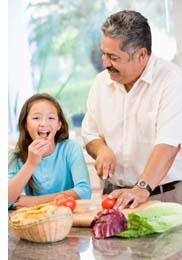Cooking is Child’s Play
- By Roxanne Crittenden
- Reading Time: 3 mins.
By Roxanne Crittenden, courtesy of Capay Valley Farm Shop
 About twice a year my 8-year old cousin Arlo comes for a “stay-over” at my house. In lots of ways, Arlo is a typical young boy—he has been fascinated with large machines since before he could walk, he likes to build things, and he loves playing outside. He is also firmly resistant to eating vegetables. If it’s green, he’s pretty sure it’s not food.
About twice a year my 8-year old cousin Arlo comes for a “stay-over” at my house. In lots of ways, Arlo is a typical young boy—he has been fascinated with large machines since before he could walk, he likes to build things, and he loves playing outside. He is also firmly resistant to eating vegetables. If it’s green, he’s pretty sure it’s not food.
So since he was little and I detected this aversion, Arlo and I have gone into my garden together to find dinner. Then we come back into the kitchen and he helps me put it together. I haven’t turned Arlo into an unabashed vegetable lover, but he’s more willing to try new things, and he is proud of the work he does in the kitchen. On one backpacking trip, he even helped harvest and cook stinging nettles for pizza.
Now clearly, not every kid will be willing to eat stinging nettles. But Arlo is a great example of what enthusiastic chefs children can be. Kids, especially young ones, love to feel helpful and will be proud to take some credit at the dinner table. And the closer kids get to their food, the more likely they are to be excited about what they’re eating.
Here are a few tasks that kids, starting about age three, can help within the kitchen. Start by putting your kiddo in an apron. Demonstrate first, then watch them start, give them a little encouragement, and let them go!
Get tips for your office
Be an office hero!Rip and Tear
You don’t have to use a knife to cook. Pull cilantro leaves off the stem, tear the basil into small pieces, rip the lettuce into bite-sized chunks for salad, pull the kale off the stem.
Wash up
Fill a shallow tray or the bottom of the sink with water and put your youngster in charge of getting the dirt off the carrots, spinach or salad greens. If the greens are fresh, they might even discover a hitch-hiking slug or snail.
Loud and Clear
Put your 2nd grader in charge of reading the recipe or getting the ingredients out.
Spin!
Salad spinners are a great tool for kids in the kitchen. Depending on the age of your kids, you may need to hold the spinner steady as they turn the handle.
Squeeze
Kids can juice citrus halves or wedges by hand, or using a simple mechanical juicer.
Grate Job!
Starting at about age 5, kids can use a grater with some supervision. Warn them about getting their fingers too close and have them call you when the chunk of cheese, carrot, or beet is getting too small.
Measure & Pour
Teach your child how to read the lines on the measuring cup and let them do the measuring and pouring. Pour the stock into soup, water into the oatmeal, milk into a baking project.
Get Crackin’!
Eggs are always fun. Young kids can crack the eggs on the edge of a bowl. Children age 8 and up can learn to separate eggs and beat egg whites for waffles or meringue cookies.
Claw and Saw
Starting at about age 7, kids can learn to safely use knives (especially serrated ones) with minimal supervision. Teach them how to keep their fingers away from the blade by making a “claw” (tucking their fingers back under their knuckles). Then show them how to use smooth sawing motions to get through bread, celery, or apple slices. You can make some initial cuts and let them do the cubing or chopping.
Remember
It doesn’t have to be perfect. With kids in the kitchen, carrots slices turn into carrot chunks and things might not rise quite like you planned. Let go of the details and let their sense of accomplishment be your reward.
Any other thoughts? How do you get your kids involved in the kitchen? These tasks are for children up to the age of about 10, but there are lots of ways to get kids of all ages excited about food and cooking. We’d love to hear what you’ve tried and how it has worked!


